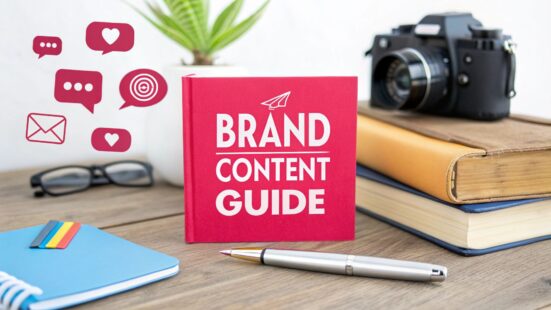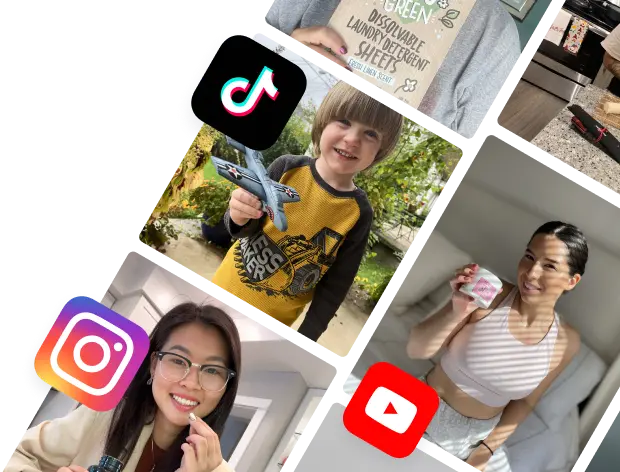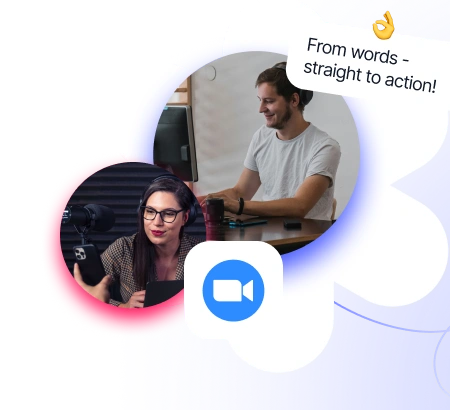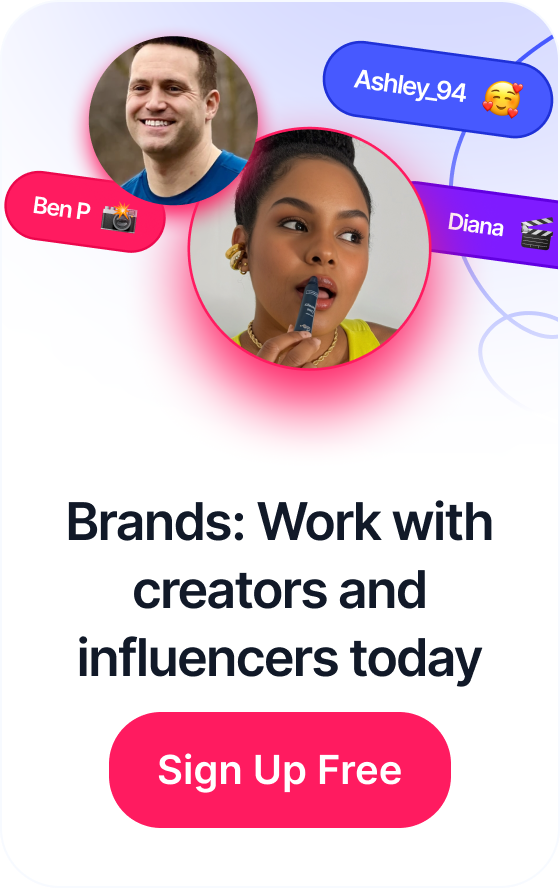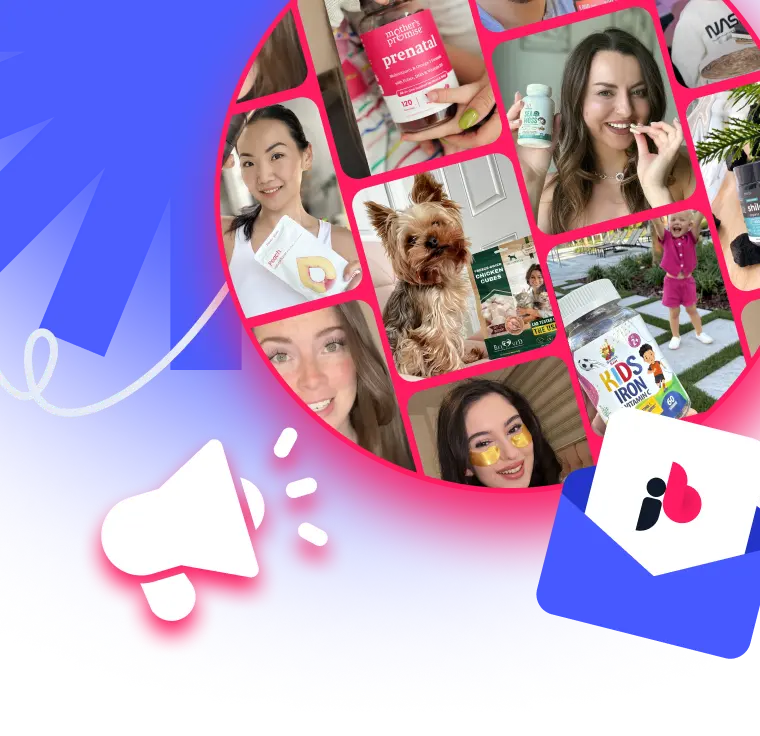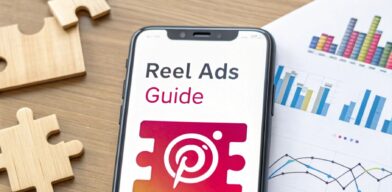 Mastering IG Reel Ads A Complete Guide
Mastering IG Reel Ads A Complete Guide
Brand content is a total departure from the hard-sell tactics of traditional advertising. Instead of pushing a product, it's about pulling people in and creating a genuine connection with them. It focuses on telling stories, sharing what your brand truly stands for, and delivering real entertainment or information that earns an audience’s attention. This approach is what builds trust and loyalty for the long haul.
Table of Contents
Going Beyond Ads To Understand Brand Content
Think of it this way: traditional advertising is the commercial break that interrupts your favorite show. Brand content is the show.
It's the difference between a magazine ad for a new hiking boot and a breathtaking short film—funded by that same boot company—about a climber's incredible journey. One is an interruption; the other is an experience you're invited to share. This shift is the absolute core of what makes brand content work.
The aim isn't to rack up immediate sales. It’s to build a relationship. By putting the audience's interests first, brands can create content that people actually want to find, watch, and share. This could be anything from a helpful how-to guide, an inspiring documentary, or even just a funny and relatable social media series.
Storytelling Over Selling
Traditional ads tell you what to buy. Brand content shows you what a brand believes in. That’s a critical distinction. It’s what allows you to build a community around shared values and interests, which is infinitely more powerful than a one-and-done customer transaction.
The philosophy is simple: instead of buying attention, earn it by creating something your audience genuinely wants to engage with. This builds an emotional connection that a 30-second ad simply cannot match.
To see just how different these two approaches are, let's break them down side-by-side.
Brand Content vs Traditional Advertising At a Glance
| Attribute | Brand Content | Traditional Advertising |
|---|---|---|
| Primary Goal | Build relationships, foster loyalty, and create community. | Drive immediate sales and promote specific products. |
| Approach | Pull marketing; attracts audience with valuable content. | Push marketing; interrupts the audience with a direct message. |
| Format | Diverse: articles, videos, podcasts, entertainment, tutorials. | Standardized: TV spots, print ads, radio commercials, banners. |
| Audience Experience | Engaging and immersive; feels like entertainment or education. | Disruptive and often intrusive; feels like a sales pitch. |
| Key Metric | Engagement, brand lift, audience growth, sentiment. | Reach, frequency, conversions, return on ad spend (ROAS). |
| Longevity | Evergreen; content provides value over a long period. | Short-term; impact fades as soon as the campaign ends. |
| Tone of Voice | Authentic, human, and conversational. | Promotional, persuasive, and corporate. |
The differences are stark. Brand content is a long-term investment in your audience, while traditional advertising is a short-term play for their wallets.

As the visual above highlights, the real power of brand content comes from its flexibility and its focus on storytelling to drive deep engagement—a world away from the limited, purely promotional nature of old-school ads.
Building Trust Through Authenticity
This relationship-first mindset is more critical now than ever before. Recent research shows that a staggering 81% of consumers need to trust a brand before they even consider making a purchase. It's a non-negotiable.
This is exactly where brand content shines.
By consistently putting out valuable and relatable stories, brands establish themselves as a credible, trusted voice. It’s not about a one-time splash; it’s about becoming a reliable source of information or entertainment in your niche. If you want to dig deeper into the strategy behind it all, exploring comprehensive content marketing resources can offer some fantastic insights.
Ultimately, this long-term investment in trust is what turns one-time buyers into passionate, lifelong advocates for your brand.
Why Brand Content Is a Strategic Imperative

It’s easy to mistake brand content for just another creative exercise, but that’s missing the bigger picture. Think of it as a core business driver. In a crowded marketplace, your brand is one of your most valuable assets, and brand content is the engine that powers it. It’s what takes you beyond one-off campaigns and builds something with real, lasting value.
This is a fundamental shift away from chasing short-term sales. Today, interrupting people with ads just doesn't work like it used to. The real goal is to become a welcome part of your audience’s world by offering content they genuinely want—whether it informs, entertains, or inspires them.
When you nail this, you’re directly fueling your most important business objectives. This is how you cut through the digital noise, build an unshakeable community, and create a competitive edge that’s almost impossible for anyone else to replicate.
Building Measurable Brand Equity
At its heart, brand content is your primary tool for building brand equity. This is the collective perception, feeling, and knowledge someone has about your brand, and it directly influences whether they buy from you.
Think of brand equity like a bank account for trust. Every piece of high-quality, helpful content is a deposit. When a brand builds up strong, positive equity, customers are more loyal, less sensitive to price, and eager to try your new products.
This kind of equity doesn't just happen. It's the cumulative result of showing up consistently and delivering on your brand's promise with every single touchpoint. From a helpful blog post to an engaging video series, the mission is to make your brand the obvious, natural choice for your ideal customer.
Fueling the Digital Marketing Engine
This pivot to brand content isn't happening in a vacuum; it’s perfectly in sync with where the market is headed. Businesses are pouring more resources into digital channels than ever before, with 72% of marketing budgets now aimed at digital efforts. It’s part of a massive trend where 63% of businesses have upped their digital marketing spend, all trying to grab a piece of a market expected to hit $786.2 billion by 2026.
In this huge digital ecosystem, brand content is the fuel. It’s what fills your social media feeds, gives your email newsletters substance, and provides the value that pulls in organic search traffic. Without a constant flow of authentic content, your digital channels are just empty shells.
Brand content is truly a cornerstone of any modern social media marketing strategy playbook. It delivers the stories and value that turn social platforms into powerful community-building tools. By investing in content that your audience actually loves, you create a self-sustaining marketing flywheel that drives growth and solidifies your brand’s place in the market.
Exploring the Core Types of Brand Content

Brand content is definitely not a one-size-fits-all game. Its real power lies in how flexible it is, taking on all sorts of shapes and forms to hit different goals and connect with people in meaningful ways. If you want to build a strategy that actually works, you have to know the main types of content and, just as importantly, when to use them.
This is about getting smarter than just "making content." It’s about picking the right format to tell the right story at precisely the right moment. Each type has a unique job, whether it’s building up your authority or just sparking a little joy.
Think of it like a musician picking an instrument. A powerful ballad just feels right on a piano, while an upbeat dance track needs that solid drum beat. In the same way, the message you want to get across will point you to the perfect content format.
Educational Content to Build Authority
One of the most powerful plays in the brand content playbook is educational content. The entire point here is to give your audience something genuinely useful. You're addressing their real-world problems, answering their burning questions, and helping them find solutions.
When you position your brand as a helpful expert, you build an incredible amount of trust and credibility. This isn't a veiled sales pitch; it's you generously sharing what you know. That’s how you establish yourself as an authority in your space.
Common formats for educational content include:
- In-depth Guides and Blog Posts: These are comprehensive articles that really dig into a topic, offering step-by-step instructions or detailed explanations.
- Tutorial Videos: A fantastic way to show, not just tell. Visuals make even complex tasks feel totally doable for your audience.
- Webinars and Workshops: Live or recorded sessions where you can share expert insights and even interact directly with your audience.
- E-books and Whitepapers: These are usually gated assets that offer huge value in exchange for an email address, making them perfect for lead generation.
This kind of content sends a clear message: "We're not just here to sell to you; we're here to help you win."
Entertaining Content to Capture Attention
Let's be real—we live in a world of endless scrolling. Sometimes the best way to cut through the noise is to make someone laugh, inspire a little wonder, or just give them a moment of fun. That's what entertaining content is all about. It’s designed to grab attention and build positive feelings around your brand.
This is where your brand's personality can really come out and play. It’s less about hard facts and more about creating a memorable, enjoyable experience.
The goal of entertainment is not to educate on product features but to make your brand a welcome and enjoyable part of your audience’s daily media consumption. This builds affection and top-of-mind awareness.
Right now, short-form video is the undisputed king of this category. Platforms like TikTok, Instagram Reels, and YouTube Shorts are built for delivering quick, engaging, and highly shareable bursts of entertainment. This could be anything from a funny skit to a behind-the-scenes glimpse of your team, or a visually stunning clip that matches your brand’s vibe.
Inspirational Content to Create Connection
Finally, we have inspirational content, which is all about connecting with your audience on a much deeper, more emotional level. This format is built on great storytelling, shared values, and celebrating human experiences.
It’s your chance to show the heart and soul behind the logo. You can do this with powerful customer success stories, mini-documentaries about your brand’s mission, or by highlighting social causes you genuinely care about. Just look at Red Bull's adventure sports content—it almost never talks about the drink itself, but it brilliantly sells a lifestyle of excitement and pushing boundaries.
When you tell stories that align with your audience's own hopes and beliefs, you build a bond that goes way beyond a simple transaction. This is how you turn customers into true brand advocates.
Partnering With Creators for Your Brand Content

One of the best ways to bring your brand content to life is by working with creators. This isn't just about paying for a quick shoutout. It's about collaborating with authentic storytellers who have already built a real connection with a community that trusts them.
When you team up with a creator, you're doing more than just getting your product in front of their followers. You're working with someone who knows exactly how to make your brand's message feel personal and real. They bring a human touch that is incredibly difficult for a corporate account to achieve on its own, making your brand feel much more approachable.
This is exactly why the creator economy is booming. Creators are masters at building relationships, and their followers see their recommendations as a hot tip from a friend, not a cold advertisement. Tapping into creator partnerships isn't just a trend anymore; it's a core part of building a modern brand, especially if you're trying to connect with a specific niche audience.
The Magic of Authentic Storytelling
The true power of creator-driven content is its authenticity. A creator’s audience follows them for their personality, their unique voice, and their style. When they weave your product into their content in a way that feels natural, the message hits with so much more impact than a traditional ad ever could.
Think of it this way: instead of a brand talking at its audience, a creator is talking with them. This two-way conversation builds a much deeper bond and fosters the kind of trust that directly impacts whether someone decides to buy. A creator's personal experience with your product acts as incredible social proof.
For example, a solid influencer marketing strategy seamlessly fits your product into the kind of content their audience already enjoys. A fitness creator might show how your protein powder is a non-negotiable part of their morning routine, or a tech reviewer could unbox your latest gadget with genuine, unscripted excitement.
Collaborating with creators gives brands a shortcut to credibility. You get to tap into communities that took years to build and borrow the trust that creators have worked so hard to earn, making your brand a natural part of the conversation.
Choosing the Right Creator Partners
Finding the right creator is everything. Your goal shouldn't be to just find the biggest account out there. You need a partner whose values and audience truly align with your brand. A bad fit feels forced, and it can hurt both your credibility and the creator's.
Here’s what you should be looking for when picking your partners:
- Audience Alignment: Does their community look like your ideal customer? Go beyond just the follower count. Dig into their audience's demographics, interests, and how they interact with the content.
- Content Authenticity: Does their content feel genuine and true to them? Their personal brand should feel like a natural extension of yours. Any collaboration should make sense, not feel like a random, disruptive ad.
- Engagement Rates: A huge follower count means nothing if no one is paying attention. Focus on creators whose posts spark real conversations, shares, and reactions. That's where the real value is.
By zeroing in on these areas, you can build partnerships that create brand content that actually works. You can even find fantastic partners on marketplaces like JoinBrands, which connects companies directly with a whole network of vetted creators who are ready to help tell your brand's story.
How to Measure Brand Content Success
So, you're creating all this great brand content. How do you actually know if it's working? Measuring success is way more of an art than a science, and it goes far beyond chasing simple vanity metrics like likes and views. The real mission is to figure out how your content is building your brand’s health and forging a real, lasting connection with your audience.
Success isn't about one viral video that blows up and then fades away. It's about consistently putting out content that gets your audience to think, feel, and—most importantly—act. You’re looking for the tell-tale signs that your stories are hitting home and turning passive scrollers into an active, engaged community.
This is exactly why you need a mix of engagement metrics and brand health metrics. Together, they paint a complete picture of your return on investment, proving that your efforts are building a valuable, long-term asset for your business.
Key Metrics for Engagement
Engagement metrics are your ground-level report. They tell you if people are actually interacting with the stuff you’re making. These are the most immediate signs that your content is hitting the mark and grabbing attention. It's proof you're not just shouting into the void.
Some of the most crucial engagement KPIs to watch are:
- Social Media Engagement Rate: This is your total interactions (likes, comments, shares) divided by your followers or reach. It’s a powerful way to gauge how compelling your content is relative to the size of your audience.
- Time on Page / Watch Time: For a blog post or a video, this tells you exactly how long you’re holding someone’s attention. A longer duration is a huge signal that your content is valuable enough for people to stick around and consume it all.
- Comments and Conversation Quality: Don't just count the comments; read them. Are people asking thoughtful questions, sharing their own experiences, or even talking to each other? That’s the sign of a healthy, budding community.
Measuring Overall Brand Health
While engagement shows you the immediate wins, brand health metrics reveal the long-term impact on your business. These are the KPIs that show your brand content is successfully building awareness, trust, and loyalty over time.
A core tenet of brand content is its role in building customer loyalty through the distribution of valuable and relevant content. Since organic social media is a primary channel, tracking these broader metrics is key.
You can get a solid read on your brand's health by looking at:
- Audience Growth: Are you steadily gaining new followers and subscribers on the platforms where you're active? Consistent, organic growth means your message is spreading and resonating.
- Brand Mentions and Sentiment: Keep an eye on how often people are talking about your brand online and, just as importantly, how they're talking about it. A spike in positive, unprompted mentions is a massive win.
- Website Traffic and Leads: At the end of the day, your brand content needs to support your business goals. A staggering 90% of businesses use content marketing, and website traffic is one of their top metrics for success. Check out how your content is driving people back to your site. You can find more content marketing statistics and insights on adamconnell.me.
The Future of Brand Content With AI
Looking down the road, it's impossible to ignore the role artificial intelligence is going to play in brand content. But let's be clear: this isn't about replacing human creativity. Think of AI as a powerful partner, a collaborator whose real talent is scaling up production and delivering personalization on a level we've never seen before.
AI is like an incredible analysis engine. It can sift through mountains of data to figure out what truly clicks with different groups of people. This lets brands stop shouting general messages and start creating content that feels like it was made just for one person. The brands that are ahead of the curve are already baking this into their strategies to stay competitive.
Scaling Creativity and Personalization
Bringing AI into marketing isn't some niche experiment anymore; it's going mainstream. It's pretty telling that 86% of companies are already using or have plans to use AI in their digital strategies. And with the AI advertising market expected to blow past $1.8 trillion by 2030, its impact will only get bigger, completely reshaping how brands build and push out content.
This shift gives brands some serious new capabilities:
- Generate Content Variations: AI can spin up dozens of versions of a single ad or post in seconds, each tweaked for different platforms and audiences.
- Predict Performance: It can spot patterns to forecast which headlines, images, or calls-to-action will perform best, even before you spend a dime on a campaign.
- Automate Routine Tasks: By taking over repetitive work like adding subtitles or doing basic edits, AI frees up your creative team to focus on the big picture—strategy and storytelling.
Mastering the Human-AI Collaboration
As AI plays a larger role in content creation, understanding how to effectively communicate with AI models through prompt engineering becomes crucial for generating high-quality brand content.
This new way of working demands a new skill. The quality of what you get out of AI is a direct reflection of the quality of the instructions you put in. This is exactly where human experience is still absolutely essential.
Knowing how to talk to these tools is the key. Getting familiar with the best practices for prompt engineering is a fantastic starting point for any team wanting to successfully weave AI into their creative workflow.
Of course. Here is the rewritten section, crafted to match the human-written style and voice from your examples.
Got Questions About Brand Content? We’ve Got Answers.
As you start wrapping your head around brand content, a few key questions always seem to come up. It's totally normal. Nailing down these distinctions is what separates a decent strategy from one that truly connects with people.
Let’s clear up some of the most common points of confusion so you can move forward with confidence.
Brand Content vs. Content Marketing: What's the Difference?
A lot of marketers throw these terms around like they’re the same thing, but they play very different roles in your overall strategy.
Think of content marketing as the entire playbook. It’s the grand plan for how you’ll attract and retain an audience by consistently creating valuable, useful stuff—like how-to guides, checklists, or educational videos.
Brand content, on the other hand, is a very specific play from that book. Its main goal isn't to get a lead or make a direct sale. It’s all about forging an emotional bond with your audience through powerful storytelling that reflects who you are and what you stand for.
Can a Small Business Really Pull This Off?
Absolutely. In fact, this is where small businesses often have an edge. Great brand content isn't about having a Hollywood-sized budget; it’s about being real, creative, and passionate.
Great brand content is about being genuine. It’s your chance to show the real people and passion behind your business, which builds a level of trust that money can’t buy.
You don't need a massive production team. Think about things like:
- Behind-the-scenes glimpses on your social media Stories.
- Showcasing awesome photos your customers sent in (hello, user-generated content!).
- Writing a blog post that shares a hard-won lesson from your business journey.
These are all low-cost, high-impact ways to build a genuine connection.
How Long Until I See Real Results?
Patience is key here. Brand content is a marathon, not a 100-yard dash. It’s designed to build deep, lasting loyalty, so if you're looking for an instant spike in sales, you're measuring the wrong thing.
While you might get some quick wins—a jump in likes, shares, and comments—the real magic happens over time. The true payoff, like rock-solid brand trust, a thriving community, and customers who stick with you for the long haul, starts to take shape after several months of consistent, authentic effort.
